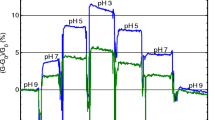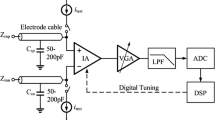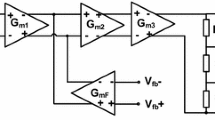Abstract
This paper presents a novel input-parasitic compensation (IPC) technique for a nanopore-based complementary metal-oxide-semiconductor (CMOS) DNA detection sensor. A resistive-feedback transimpedance amplifier is typically adopted as the headstage of a DNA detection sensor to amplify the minute ionic currents generated from a nanopore and convert them to a readable voltage range for digitization. But, parasitic capacitances arising from the headstage input and the nanopore often cause headstage saturation during nanopore sensing, thereby resulting in significant DNA data loss. To compensate for the unwanted saturation, in this work, we propose an area-efficient and automated IPC technique, customized for a low-noise DNA detection sensor, fabricated using a 0.35-μm CMOS process; we demonstrated this prototype in a benchtop test using an α-hemolysin (α-HL) protein nanopore.
Similar content being viewed by others
References
R. Maitra, J. Kim and W. Dunbar, Electrophoresis 33, 3418 (2012).
J. Shi, J. Hou and Y. Fang, Microchimica Acta 183, 925 (2016).
K. Lieberman, G. Cherf, M. Doody, F. Olasagasti, Y. Kolodji and M. Akeson, J. Am. Chem. Soc. 132, 17961 (2010).
H. Wang, N. Hurt and W. Dunbar, ACS Nano 7, 3876 (2013).
J. Kim, R. Maitra, K. Pedrotti and W. Dunbar, Sensor Actuat. B-Chem. 177, 1075 (2013).
J. Prakash, J. Paulos and D. Jesen, J. Neurosci. Methods 27, 165 (1989).
P. Weerakoon, E. Culurciello, K. Klemic and F. Sigworth, IEEE Trans. Biomed. Circuits Syst. 3, 117 (2009).
J.T. Yokichi, US Patent 7741829 (2010).
J. Kim, R. Maitra, K. Pedrotti and W. Dunbar, IEEE Trans. Biomed. Circ. Syst. 7, 285 (2013).
G. Baaken, N. Ankri, A. Schuler, J. Ruhe and J. Behrends, ACS Nano 5, 8080 (2011).
J. Kim and W. Dunbar, Sensor Actuat. B-Chem. 234, 273 (2016).
J. Huang, Y. Kin, K. Huang and R. Liu, Microelectronics and Solid State Electronics 1, 74 (2012).
W. Dunbar and J. Kim, US Patent 8961763 (2015).
Author information
Authors and Affiliations
Corresponding author
Rights and permissions
About this article
Cite this article
Kim, J. A novel input-parasitic compensation technique for a nanopore-based CMOS DNA detection sensor. Journal of the Korean Physical Society 69, 1705–1710 (2016). https://doi.org/10.3938/jkps.69.1705
Received:
Accepted:
Published:
Issue Date:
DOI: https://doi.org/10.3938/jkps.69.1705
Keywords
- Biophysics
- Nanopore device
- Single-molecule analysis
- DNA detection sensor
- Dead-time compensation
- α-hemolysin pore
- Bioinstrumentation




